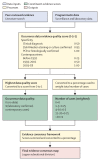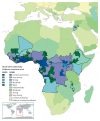Mapping the global distribution of Buruli ulcer: a systematic review with evidence consensus
- PMID: 31200890
- PMCID: PMC6614043
- DOI: 10.1016/S2214-109X(19)30171-8
Mapping the global distribution of Buruli ulcer: a systematic review with evidence consensus
Abstract
Background: Buruli ulcer can cause disfigurement and long-term loss of function. It is underdiagnosed and under-reported, and its current distribution is unclear. We aimed to synthesise and evaluate data on Buruli ulcer prevalence and distribution.
Methods: We did a systematic review of Buruli ulcer prevalence and used an evidence consensus framework to describe and evaluate evidence for Buruli ulcer distribution worldwide. We searched PubMed and Web of Science databases from inception to Aug 6, 2018, for records of Buruli ulcer and Mycobacterium ulcerans detection, with no limits on study type, publication date, participant population, or location. English, French, and Spanish language publications were included. We included population-based surveys presenting Buruli ulcer prevalence estimates, or data that allowed prevalence to be estimated, in the systematic review. We extracted geographical data on the occurrence of Buruli ulcer cases and M ulcerans detection from studies of any type for the evidence consensus framework; articles that did not report original data were excluded. For the main analysis, we extracted prevalence estimates from included surveys and calculated 95% CIs using Byar's method. We included occurrence records, reports to WHO and the Global Infectious Diseases and Epidemiology Network, and surveillance data from Buruli ulcer control programmes in the evidence consensus framework to grade the strength of evidence for Buruli ulcer endemicity. This study is registered with PROSPERO, number CRD42018116260.
Findings: 2763 titles met the search criteria. We extracted prevalence estimates from ten studies and occurrence data from 208 studies and five unpublished surveillance datasets. Prevalence estimates within study areas ranged from 3·2 (95% CI 3·1-3·3) cases per 10 000 population in Côte d'Ivoire to 26·9 (23·5-30·7) cases per 10 000 population in Benin. There was evidence of Buruli ulcer in 32 countries and consensus on presence in 12.
Interpretation: The global distribution of Buruli ulcer is uncertain and potentially wider than currently recognised. Our findings represent the strongest available evidence on Buruli ulcer distribution so far and have many potential applications, from directing surveillance activities to informing burden estimates.
Funding: AIM Initiative.
Copyright © 2019 The Author(s). Published by Elsevier Ltd. This is an Open Access article under the CC BY 4.0 license. Published by Elsevier Ltd.. All rights reserved.
Conflict of interest statement
We declare no competing interests.
Figures







Comment in
-
Buruli ulcer: here today but where tomorrow?Lancet Glob Health. 2019 Jul;7(7):e821-e822. doi: 10.1016/S2214-109X(19)30233-5. Lancet Glob Health. 2019. PMID: 31200878 No abstract available.
References
-
- WHO. Buruli ulcer—number of new reported cases Global Health Observatory data repository. [accessed Jan 10, 2018]; http://apps.who.int/gho/data/node.main.A1631.
-
- Berger S. Tropical skin ulcers: global status. Gideon Informatics Inc; 2018.
-
- WHO. Buruli ulcer (Mycobacterium ulcerans infection) [accessed March 1, 2018]; http://www.who.int/mediacentre/factsheets/fs199/en/
-
- Roltgen K, Pluschke G. Epidemiology and disease burden of Buruli ulcer: a review. Res Rep Trop Med. 2015;6:59–73.
-
- Kanga JM. Aspects épidémiologiques de l’ulcère de Buruli en Côte d’Ivoire: résultats d’une enquête nationale. Bull Soc Pathol Exot. 2001;94:46–51. - PubMed
Publication types
MeSH terms
Grants and funding
LinkOut - more resources
Full Text Sources
Miscellaneous

